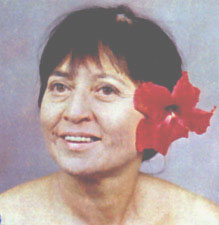-
Hula Recollections of Isabel Kamakanoenoe Hapai Sagote April 4, 1999
When I was young, my grandmother, Hulimai Morrison would teach and sing us meles that belonged to the various districts, as we travelled around the island of Hawaii. I developed a great love for hula auana and in 1948, when I was about 11 or 12, I was allowed to study hula olapa with a relative, Iolani Luahine. Her studio was in Kaimuki, within walking distance of our home on 12th and Harding Avenues. I remember the lauhala mats in the front of the studio, and a young woman, who was her assistant. I don't think she was Hoakalei Kamauu. There were 5 or 6 of us, but the only other student I remember is my aunt, Eloise Lilinoe Hapai Haili, about age 15 or 16.
This is the fashion in which we were taught. We would learn an olapa danced with only one hula step. The first olapa I learned was all vamp or kaholo done in different directions. When we were proficient in the kaholo, we would learn another olapa with a different hula step. Each step had a unique beat; we did not have to learn the name of the step, only the beat that signalled the step. When we turned our heels out, parallel with our toes, in the hela, or pushed our knees open instead of up, in the uwehe, we were whacked with the puili. Each step had to be executed properly before we progressed to a new hula movement. We learned ten olapa, each one in a different step, the last three combining all the hula steps. When the beat changed, the step changed. Iolani believed hula was drama and poetry in motion. The dancer was only the vessel to express the story. The dancer had to become the subject, whether it was a pig scurrying around or a tree swaying in the wind. Facial expression, when warranted, was an integral part of hula.
I made my uniki when I was 17 or 18. The graduating dancers gathered at the studio early in the morning where a kuahu was set up. We had a meal together; I remember only the crushed vana. We made our ti leaf skirts and leis, then went home to await our uniki at twilight. We performed hula olapa with Hoakalei Kamauu, as the chanter. This was the olapa program for the uniki:
-
Kawika - vamp, kaholo
Liliu E - uwehe
Ula No Weo - hela
Kalakaua - kalakaua, kawelu
Aia La O Pele I Hawaii
Heeia
Kahi Kai O Mamala
He Mai No Iolani

We were not awarded certificates, but Iolani told me, "You will never forget these dances".
My greatest desire was to learn hula auana. When I was 15, I studied with Alice Keawekane Garner at Kapaolono Park and the YWCA on Richards Street. The first hula I learned from her was Papalina Lahilahi. I also danced at the Kodak Hula Show for eight years under the direction of Louise Akeo Silva, but my hula mentors were Lois Guerrero and Isabel Sherman.
Question: What is the background of your name?
Answer: There were two brothers from Upolu, Apia, Western Samoa. One brother killed his nephew, was banished and left with Pao`o, for Hawaii. His son, Hewa-hewa-nui-a-mahi or Hapa-kua-hewa-hewa, born in Hawai`i, was an advisor to Kamehameha I and keeper of his war god, Ku-kaili-moku. His obituary is in the Hawaii State Archives. He never married, but his niece (sister's daughter) was Kamakanoenoe, and I am the namesake.